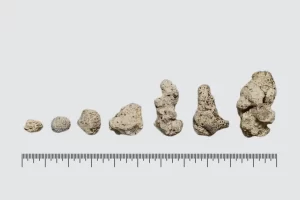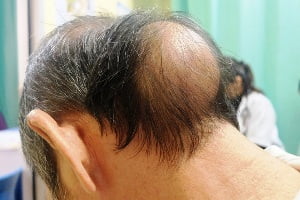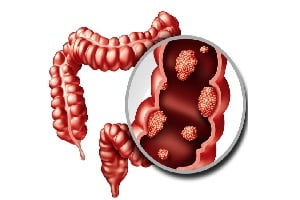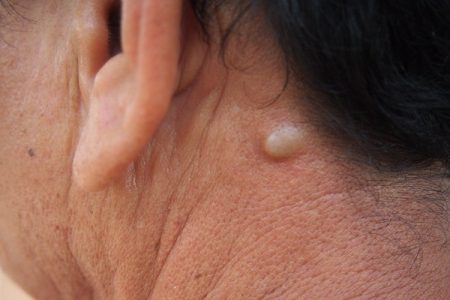Lump or knot on head
A lump is a swollen area which can appear anywhere on the body and in most cases, is harmless. Commonly, lumps or bumps appear on the skin or under the skin anywhere in the body but there is lesser chance that bumps will occur on bones to form such as lumps on head or skull. On or inside the skin, lumps appear as cysts, abscesses, lesions, warts, etc due to skin infections, allergies, ingrown hair, etc and on the bones lumps may appear due to injury, abnormal growth, etc.
The lavender essential oil contains soothing properties that may heal head bumps.
Symptoms of lumps on scalp
Lump on head is very common due to several reasons. In most cases, a person might feel some localized pain in head which goes away itself in a day or two. In some cases, a knot on head might be felt for a long time which can cause severe problems such as a hematoma or concussion when detected. Such complications need immediate medical attention. The symptoms of lump on head caused due to various reasons are:
- Round or oval shaped swellings are observed as lumps in or above the skin
- Some lumps can be painful.
- Lumps can sometimes even change their color and shape or become irregular in shape if irritated.
- Lumps on skin which occur due to an infection form small lesions or hard clusters or bumps on the skin.
- Continuous itchiness and redness is observed on the skin.
- Minor head injury leaves bruises or bump on head.
Causes of bump on head
Round, raised areas on head are usually painless and in most cases are harmless. There can be multiple conditions which can cause lumps on head, such as:
Ingrown hair
Ingrown hair is that which grows into the skin, rather than growing through it. This leads to the formation of some small, red, solid bumps. Sometimes, ingrown hair on head can become infected and turn into pus-filled bumps but these are generally harmless.
Seborrheic keratoses
Seborrheic keratoses are very commonly observed on the head and neck in middle-age people. These bumps are non-cancerous skin growths (like warts). There are usually risk-free and are rarely treated. In uncommon situations, they are suspected to cause skin cancer therefore it is suggested by the doctors to remove these lumps using cryotherapy or electrosurgery.
Head injury
Due to some head injury, a lump on top of head can be felt. This should not be taken lightly as it leads to the formation of a blood clot. If it does not go away in two or three days, it can lead to several complications such as loss of vision, hemorrhage, intracranial hematoma, etc. Head injury should not be ignored as it can lead to permanent damage to the body.
Bone Tumors
Bone tumors often lead to the formation of lumps on head. Uncontrolled bone cell division leads to the formation of a lump or knot on head which is commonly benign (non-cancerous) in nature. Bone tumors should be treated even if it causes a minor discomfort.
Pilar Cysts
Pilar cysts are round painless lumps on the skin (of head-scalp). They can be of variant sizes. Cysts are a collection of oil and dead skin cells under the top layer of the scalp and are more common in women. Head cysts can weaken the hair follicles and result in temporary falling of hair. Similar to pilar cysts are epidermoid cysts. Epidermoid cysts are harmless, small, hard bumps which usually form due to keratin settlement under the skin.
Calcified Bone
Calcification is a process of accumulation of some amount of calcium in body tissues which lead to the formation of a hard lump in a particular area. When some calcium is collected in head tissue during the healing process of musculoskeletal injuries and is not excreted, it results in hardening of those tissues. Calcification cannot be revered and is generally not curable. However, preventive action can be taken to treat disorders associated with calcification.
Sometimes, exostosis occurs due to excess calcium. During exostosis, a bone grows on top of an existing bone. An X-ray is used to determine that the bump on head is an exostosis. Treatments for such bony growths depend on the complications which arise due to them.
There are some other causes which might lead to the formation of some kind of lump on head such as moles, acne or pimples on scalp skin, some cancerous growths on scalp, folliculitis, pilomatrixoma, etc.
Can a lump on your head be Cancer?
Cancers, including those affecting the head, can lead to noticeable lumps on or just below the skin. However, it’s crucial to understand that not all lumps or bumps indicate cancer; there can be various reasons for their appearance. Regardless, any newly discovered lump or change in the skin should be assessed by a healthcare professional to determine its nature. A significant portion of head and neck cancers begin in the moist linings of areas like the mouth, nose, or throat. Often, symptoms may present as a fresh lump in the head or neck region, swollen lymph nodes, or continuous sores in the oral or nasal passages. Other indicators might include persistent throat discomfort, challenges in swallowing, or changes in voice.
Typically, cancerous lumps on the head are firm and don’t cause pain upon touch. They often appear suddenly and consistently grow over time. If you notice any unusual health changes, especially in the form of lumps, it’s essential to consult a physician.
Head bump treatment
A lump on top of head goes away itself in a few days. However, if it does not go away then it might cause a serious problem and needs proper medical attention.
- Proper medications should be given to treat severe lumps on scalp. Some of them are malathion and lindane. Lumps that have some chances of developing into skin cancer can be treated by using the injections of cancer drug directly in to the cancerous growth on the scalp.
- Sometimes liquid nitrogen is used to treat head bumps. Liquid nitrogen freezes and flattens the growth or lumps and inhibits them to spread to any other area. This type of treatment is also known as Cryotherapy.
- Surgery is necessary to remove large or infected lumps, bumps or the cysts on or in the scalp. Electro surgery is preferred when a needle is used to send some electrical charges through the lump on head and vaporize the growth in such a way that the hardened tissue can be scraped off.
- Other treatments which can be considered for lumps on scalp are light therapy which may aid in clearing some of the lumps caused due to skin problems like that of psoriasis, etc.
- Some home remedies such as use of neem, heena, apple cider vinegar, nutmeg powder, essential oils, etc reduce infections on the scalp.
- Greasiness in hair and scalp should be avoided to prevent skin diseases
- Sulphur-based hair products reduce acne lumps on the scalp.
Frequently Asked Questions
Is it normal to have lumps on your head?
Yes, it is relatively common to have lumps on your head. These lumps can be caused by various factors such as minor injuries, cysts, ingrown hair, or benign skin growths. Most lumps are harmless and resolve on their own. However, if a lump persists, grows in size, or is accompanied by pain or other symptoms, it is recommended to consult a healthcare professional and avoid any more uncommon issues timely.
Can lumps on head be cancer?
Most lumps on the head are benign and not cancerous, however some lumps may be cancer, particularly if they are hard, painless, grow steadily, or appear suddenly without an apparent cause. Cancerous lumps are more likely to be firm and do not disappear on their own. It is important to have any unexplained lump evaluated by a doctor to rule out serious conditions, including cancer.
I have a painless lump on my head for years. Can it be risky?
A painless lump on the head that has been present for years is often benign, such as a cyst, calcified tissue, or lipoma. However, it is still important to monitor any changes in size, shape, or texture over time. Rarely, long-standing lumps can pose risks or become problematic. For peace of mind and to rule out any potential health concerns, it is advisable to consult a medical doctor who will evaluate it and rule out any serious problems.
How long do lumps on the head last?
The duration of a lump on the head depends on its cause. • In case of minor injuries: Lumps from injuries typically subside within a few days to a week. • Cysts or benign growths: These can last for years without significant change unless treated. • Infections or abscesses: These may persist until the underlying infection is resolved. If a lump does not heal or continues to grow, you should seek a medical consultation from a specialist for proper diagnosis and treatment of the lump on your head.






